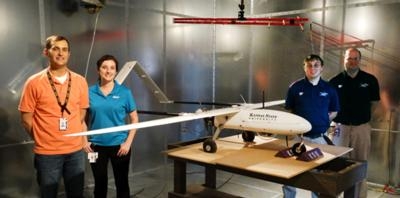Fri, Apr 17, 2015
Goal Is To Minimize Risk Of UAV Operations In The NAS
Two Kansas universities are working together with the FAA to minimize the risk associated with the operation of unmanned aerial systems (UAS) operating in the National Airspace System.

Recently Wichita State University's National Institute for Aviation Research (NIAR) and the Kansas State University Applied Aviation Research Center on the Salina campus conducted radiated susceptibility testing on a gasoline-powered, fixed-wing aircraft weighing 50 pounds with an 11-foot wingspan in a reverberation chamber at NIAR.
The radiated susceptibility testing was conducted to determine whether the aircraft's electronic systems will operate as intended when exposed to radio frequency, such as that emitted from broadcasting antennas and radio stations.
The tests are part of a larger effort by K-State Salina to validate the ASTM F38 Committee's standards for small unmanned aircraft systems.
"This partnership and subsequent research will achieve a broader understanding of the ASTM F38 requirements," said Tom Aldag, director of R&D for NIAR. "It will help us determine where the standard is overly restrictive and where there are gaps. The goal is to have a useful set of standards that benefits the UAS industry."
Wichita State is supporting K-State Salina in researching the environmental effects on UAS, especially in the areas of electromagnetic susceptibility, vibration and temperature variation. Together, they hope to achieve standardized test methods that the UAS industry can utilize in order to maintain public safety and well-being while benefiting from the wide range of applications and resources provided by UASs.
The project will conclude when required testing and evaluation has been completed and conclusions can be drawn about all applicable standards. The final project report will outline the project findings and include a gap analysis to show where the standards may have been insufficient to mitigate established operational risks. It will also include recommendations for changes to the standards that will close gaps where possible and allow for risk to be mitigated to a greater degree.
The tests were performed in NIAR's Environmental and Electromagnetic Test Labs, which will soon move to Air Capital Flight Line, formerly the site of the Boeing Company.
(Image provided by NIAR)
More News
He Attempted To Restart The Engine Three Times. On The Third Restart Attempt, He Noticed That Flames Were Coming Out From The Right Wing Near The Fuel Cap Analysis: The pilot repor>[...]
Make Sure You NEVER Miss A New Story From Aero-News Network Do you ever feel like you never see posts from a certain person or page on Facebook or Instagram? Here’s how you c>[...]
From 2009 (YouTube Edition): Leading Air Show Performers Give Their Best Advice for Newcomers On December 6th through December 9th, the Paris Las Vegas Hotel hosted over 1,500 air >[...]
Aero Linx: NASA ASRS ASRS captures confidential reports, analyzes the resulting aviation safety data, and disseminates vital information to the aviation community. The ASRS is an i>[...]
“For our inaugural Pylon Racing Seminar in Roswell, we were thrilled to certify 60 pilots across our six closed-course pylon race classes. Not only did this year’s PRS >[...]
 NTSB Final Report: Rutan Long-EZ
NTSB Final Report: Rutan Long-EZ ANN FAQ: Turn On Post Notifications
ANN FAQ: Turn On Post Notifications Classic Aero-TV: ICAS Perspectives - Advice for New Air Show Performers
Classic Aero-TV: ICAS Perspectives - Advice for New Air Show Performers ANN's Daily Aero-Linx (06.28.25)
ANN's Daily Aero-Linx (06.28.25) Aero-News: Quote of the Day (06.28.25)
Aero-News: Quote of the Day (06.28.25)



